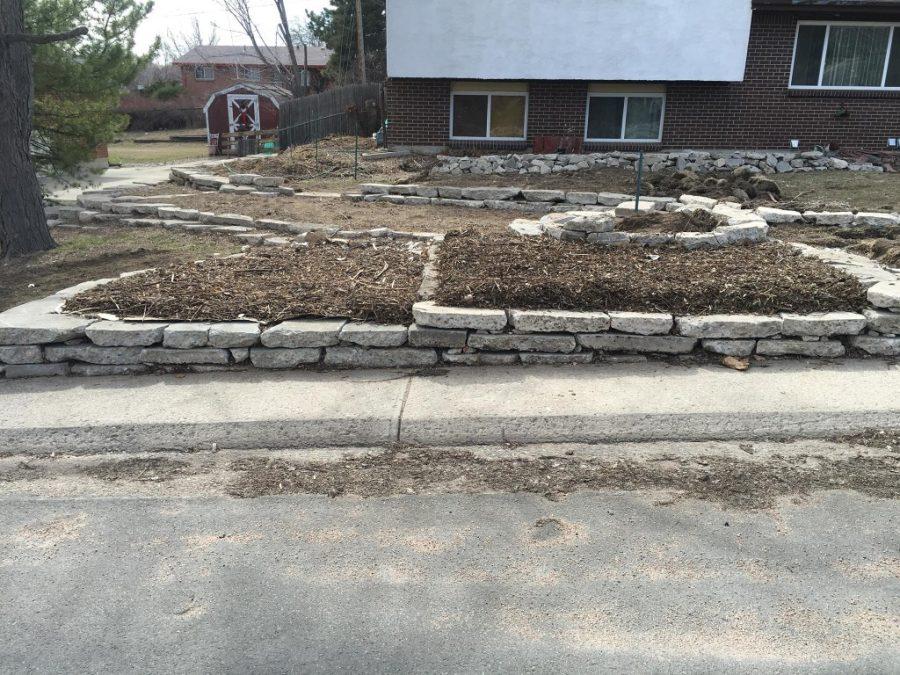
When we’re thinking about what we can do to help the environment or just make our homes and yards more interesting than a few blades of grass the word “permaculture” should come to mind. Permaculture is the idea of permeate agriculture, and using our knowledge of our ecosystems to create sustainable places where people are guided by three ethics: care of the earth, care of the people, and reinvest all surplus; whether it be information, money, or labor, to support the first two ethics.
Sound like a little too much? Think of this way, we can use what we grow to feed ourselves (and perhaps others if there is enough), we can find ways to grow this food in ways that does not harm our environment, and surplus can mean throwing all of your fall leaves into a compost heap, or using wood from a tree you had to cut down instead of sending it off to the landfill.
Still have questions? Don’t worry, we contacted Mathew Hajek, a student at the Suburban Bare Test Farm, who spent last summer documenting the transformation of his front yard on his Facebook page.
College Avenue: How did you find out about permaculture?
Mathew Hajek: I was researching different ideas for building raised beds as well as ideas for how to setup my own aquaponics system when I came across the word “permaculture” casually mentioned in a forum. I didn’t know what it was and so I checked it out, from there it’s been a domino effect of researching permaculture and related fields, adapting to live a permaculture lifestyle, and incorporating permaculture with my university studies and research.
CA: What was the selling point for you on the whole movement?
Hajek: Permaculture at its most basic level an ethic and design system. Care for earth, care for people, return of surpluses. This supports my general worldview and personal values opposed to social, cultural and ecological destructive practices and institutions. My initial adoption of permaculture was more pragmatic than anything else. As I’ve studied permaculture I’ve found its principles invaluable in how to live my life and its principles as a cornerstone for what I think is a necessary global cultural shift in order to mitigate climate change and have a realistic shot at developing a sustainable, equitable, and just human future on this planet. Permaculture originally meant permanent agriculture – agriculture that mimics natural ecosystems – and has evolved to also mean permanent culture, these together further support my worldview in preserving world cultures and ecosystems by lessening our (Western) influences on both. I cherish diversity.
CA: Why permaculture? Why not a traditional farm?
Hajek: Based on the following questions I’m assuming you mean why my home yard instead of a farm, because there’s also the conventional versus organic versus regenerative versus permaculture aspect of why not a traditional farm and though I’d love to go into those in detail, that’s a big topic all on its own. In any event, I chose to convert my yard to a food forest governed by permaculture principles because my lawn is otherwise a biological desert in the middle of biological desert known as the suburbs. Likewise, I already live here and it makes the most sense as I don’t know when or if I’d be in the position to move, so I practice where I live. Lawn is a massive resource consumer with no tangible ecosystem services and supports minimal biodiversity with low accumulation of biomass, three things necessary for healthy ecosystem function and active carbon sequestration. My house is located in an area that was once wooded and the climate still supports a woodland environment that we have to actively fight against by annually pulling out tree seedlings and rhizomes as weeds just to keep a clean lawn. So guiding the succession and evolution of a forest to provide wildlife habitat and food while lowering my ecological footprint makes sense. Now if I had the resources I’d definitely buy land and do a much larger scale permaculture farm, however it’s also important for other urban and suburban dwellers to see functioning models of sustainability in a suburban setting because for the grand majority of people urban and suburban environments are their only options where a move to the country is a luxury of privilege.
CA: How long did it take you design the garden/farm?
Hajek: The initial sketch-up took about a year, however the design process is never ending because I’m managing a human ecosystem and ecosystems evolve and change over time. One of the big principles of permaculture as co-founder Bill Mollison puts it is “protracted and thoughtful observation [of the ecosystem], not protracted and thoughtless action.” So in that regard I’m constantly observing and redesigning.
CA: How did you begin to prepare to change your yard?
Hajek: The front yard I hadn’t planned on starting for a couple more years, however one of my neighbors had their driveway replaced and I couldn’t let all that carbon expensive concrete go to the landfill when I had a perfectly good use for it. Another permaculture principle, reducing/closing waste streams and making the problem the solution. So I asked the concrete company to dump it all in my yard, signed a waiver for their comfort, then spent late summer of 2015 building the physical infrastructure of the front yard landscape. It’s about 80% complete and I expect to have it done this year. Where I can, I’ve planted out some of the early succession shrubs and herbs that I started from seed last year. The back I plan on partially trellising with cut logs from an old growth silver maple I’m having removed this year, it’s a safety hazard and instead of the wood going to the dump it’ll help build perennial garden beds, retain water in the soil, stop erosion of my yard and provide all sorts of habitat while growing mushrooms to boot. Stacking functions.
CA: Where there any unforeseen challenges that slowed conversion of your yard into a garden/farm?
Hajek: No real unforeseen challenges. Costs are certainly an issue that can slow things down, however I knew this going into the project and planned accordingly. I save what I can over the year for big ticket items; this spring I’m converting part of my driveway to sub irrigated raised beds for annual crops and water conservation. I save a portion of the yearly savings year over year for new construction; I have plans for an 800 square foot greenhouse and an atrium that will passively heat and cool my house, replacing the furnace and the need to burn natural gas for heat. I start everything I possibly can from seed to both save costs and fulfill my requirement for promoting a high level of biological diversity. I also free-source most of the inputs I need. One of the unforeseen benefits of an urban or suburban environment is the excessive waste streams make resource gathering rather easy.

CA: Did you have any problems with the city when you began construction? Did you need to acquire any permits?
Hajek: While I can’t speak for other municipalities, Lakewood in general is really relaxed about codes. The only thing the city really didn’t like was when the concrete was first delivered, it was an eyesore. But otherwise I researched city ordinances prior to starting and don’t need to get permits since I’m not changing the grade of the land, building walls over 30 inches, or building structures over 100 foot squared. When it comes time to build the greenhouse and atrium I will need to get permits and have a city planner approve my plans, however again Lakewood is really good at working with homeowners to achieve win-win results, the city is really proactive with homeowners wanting to improve their property or start a business. The biggest thing I’d suggest to anyone considering anything like this is to check on their city and county websites and research codes, ordinances, and enforcement.
CA: What kind of variety do you have in the garden?
Hajek: currently I have lots of ephemerals like daffodil, tulip, crocus, hyacinth, and wild allium as well as perennial and self seeding annual wildflower mixes. I have some plum trees, grape vines, and brambles on order, however most of my herbs and shrubs are seedlings I start and keep in my mini-nursery. While food production is a primary goal for this specific forest, I have to consider exactly what ecosystem services each plant provides and requires, then plan, design, observe and redesign for every component I add. In addition, I want to develop most of the support species communities before really going all in with the big food producing perennials. However, I plan and plant an annual vegetable garden every year in every portion of my yard that I’m not actively working in, so I can grow lots of food while observing how the different microclimates affect different plant types. I also keep chickens for bug control, sustainable phosphorus production, compost turning, and eggs. My zoning allows for two apiaries on my lot, so once I’ve got more bee forage established I’ll introduce an apiary to the forest. In addition I build habitat every year for the native wasps, hornets, bumbles, and carpenter bees as they all fill different ecosystem niches and are equally threatened with extinction.
CA: A yard is a lot of space for fruits and vegetables, do you can/freeze your extra produce?
Hajek: As of right now I do not, most of my vegetables are either eaten the day they are picked or some like squash, carrots, and brussels I store over winter to lower my expenses and ecological impact. Less trips to the grocery. Once I have enough production to warrant it, I plan on building a simple solar dehydrator and will expand to canning as the need arises.
CA: Do you sell your extra produce or do you think you might do so in the future?
Hajek: I don’t sell anything as of now, primarily because my family eats most of the food fresh. However I do plan to sell produce and mushrooms in the future as production picks up (perennial systems have a five to ten year delay on production payback after initial investment). The City of Lakewood has many farmers markets as well as an ordinance allowing home garden sales of produce.
CA: What advice do you have for people who may want to start this in their own yards?
Hajek: Research and plan and really see if its something you want to do. I think everyone should do it or hire someone like me to do it, however the reality is its a large investment in time, energy and money. Take it one step at a time and start small before expanding. Definitely recognize patience and observation are absolute necessities for a successful and productive home ecosystem. Most importantly, if someone is serious about learning permaculture and integrating it with their life and lifestyle, then take a permaculture course or earn the permaculture design certificate (PDC) from a reputable PDC instructor who can show their educational credentials and education lineage all the way back to BIll Mollison, David Holmgren, Eric Toensmeier, or one of the recognized master permaculturalists. If they cant or wont, then they’re not legitimate PDC instructors. The reason for this is because PDC is still a young industry and we want to continue to establish and project and protect its credibility, especially because there are some scam artists currently capitalizing on the fact that permaculture is still not well known.

CA: Do you have any advice for people who live in apartments that may not have yard space?
Hajek: Remember that permaculture is an ethic and a design system, so don’t let yards and space be the final deciding factor. There are all sorts of ways to integrate the principles of permaculture into our lives, agriculture is just one of an infinite array. Think in terms of stacking as many functions into a single item as possible, reducing waste streams or closing waste to product cycles, always ask if what you are doing is caring for planet, people, and returning surpluses or excesses. Apartment dwellers can still compost most of their food scraps the same as suburban or rural dwellers, they can grow food vertically in their home or on a balcony, they can join a community garden or CSA, donate to organizations like Heifer International who helps families and communities in third world countries develop sustainable food systems, write to your state and local representatives asking for more ecologically sound practices in agriculture, animal farming, lumber production, water use, and so on, guerilla garden. We have a serious climate crisis approaching fast and its nothing more than a physics equation, too much carbon from ground based sinks (fossil fuels, soil carbon, and terrestrial biomass) has been transferred to climate affecting sinks (the atmosphere and oceans), sound practices in ecosystem management in conjunction with dramatic decreases on CO2 and Methane (CH4) emissions will stop and reverse the crisis, and permaculture as an ethic, daily principle, agricultural system, and cultural ideology is a major cornerstone in affecting serious social, cultural, and ecological change for the positive. So go for it irrespective of perceived limitations, make the problem into the solution.




































